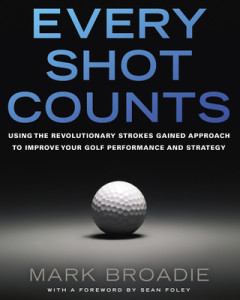I am currently reading Mark Broadie’s “Every Shot Counts.” If the name doesn’t ring a bell, he’s the Columbia University business professor that revolutionized how the PGA Tour looks at scoring.
That all important “strokes gained putting” statistic is Broadie’s baby. For years golfers thought that the total number of putts was the best indicator of putting prowess. Not so according to the good professor.
Broadie’s book is full of heavy duty math and sometimes may be a bit difficult, I like to say I am reading and re-reading it. But anyway, Broadie is pretty damn smart and as a professor he knows the value of a good summary and he does that at the end of each chapter. In chapter one he blows up a few hundred years of our misguided belief in the value of putting.
A few of his thoughts:
Since the beginning of golf itself, people have over estimated the importance of putting.
The overemphasis on putting is partly due to an approach based on hunches rather than on data and partly due to cherry-picking some bits of data while ignoring others.
A stroke lost by a wild drive is as important to your score as a stroke lost by missing a putt.
One of Broadie’s bottom lines is that putting isn’t as important to our scores as we always thought it was.
Broadie also has columns in Golf Magazine and Golf.com where he champions his radical statistical analysis of the game he loves and plays very well.
That old adage you hear every time you play, “drive for show and putt for dough” is absolute hogwash.
Broadie has set the golf world on its ear as he says putting is not the most significant factor in scoring.
Putting is the factor that least influences our scores according to Broadie. Here is Broadie’s breakdown.
Believe it or not, approach shots –which include tee shots on par 3s and second shots on par 4s –affect the scoring average of better players more than any other category. (Drives are the next most impactful category, followed by the short game and putting.) Click here for his Golf.com column that will open your eyes.
So it’s Approaches, Driving, Short Game and then Putting.
Broadie says, “A 90’s shooter leaves his average approach shot about one club short of the hole. Distance plays a bigger role than direction.”
It’s approaches that really matter and I guess I kind of knew that on some level. I know that I score better when I hit more greens in regulation where I can hopefully two putt. But what the heck good is a two putt if your not on in regulation.
And I know that I, and my buddies score better when they play from the fairway. Last season during a Captain & Crew Scramble, where the foursome all hit a drive and then chooses the best one and each plays their own ball from there my buddy shot a 78. For someone that shoots in the mid 90’s that’s saying something.
I guess I knew that too, playing from the middle of the fairway is a bit easier than having to punch out from the trees with your second shot.
Hit in in the fairway, hit the green and then break out the putter. That’s how you score. Forget the “putt for dough” routine.
It is hitting the green that is important and it’s easier to hit a green from the fairway.
But I guess we always knew that too, and Broadie has the numbers to back that up.
